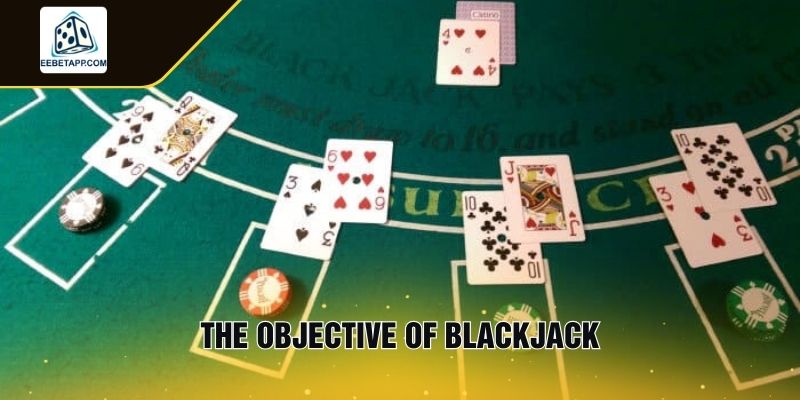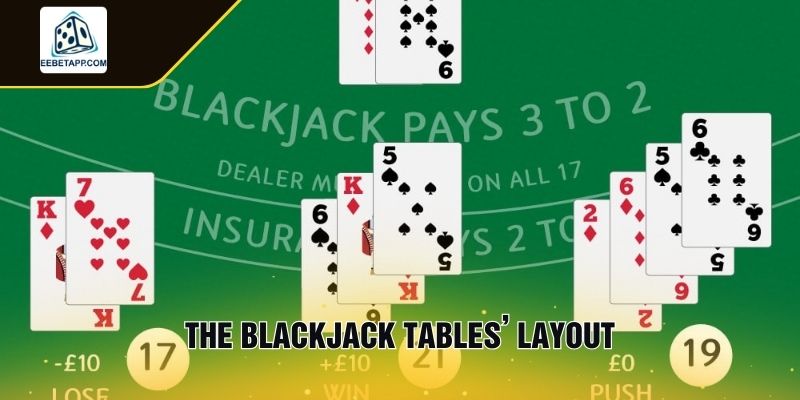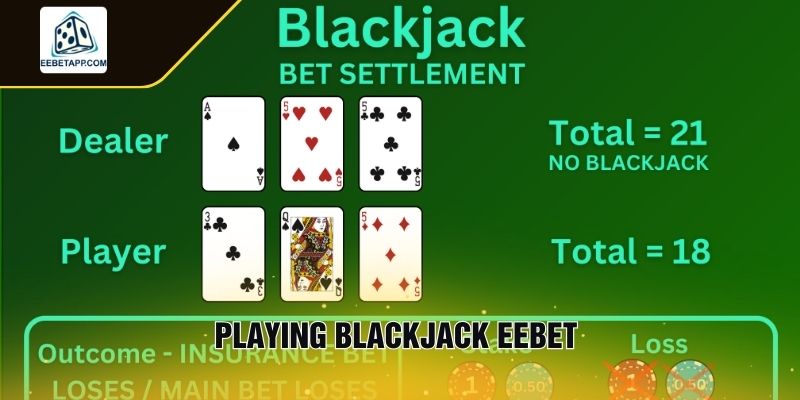Blackjack is a timeless casino classic, blending strategy and chance to create a game that captivates beginners and seasoned players alike. If you’re new to this exciting world, understanding the fundamentals is crucial to enhance your gameplay and avoid common pitfalls. This comprehensive guide to how to play blackjack EEBET covers everything from the game’s objectives and rules to advanced strategies, special situations, and common variants masquerading as blackjack. Get ready to elevate your skills and enjoy a more rewarding blackjack experience!
The Objective of Blackjack
The primary aim in blackjack is straightforward: to outmatch the dealer. While misunderstandings about the game’s purpose may exist, success essentially boils down to achieving a better outcome than the dealer.
Victory can be secured in several ways: obtaining a hand total that surpasses the dealer’s, ensuring the dealer’s hand exceeds 21, or starting the game with a perfect total of 21 in your first two cards, provided the dealer does not match this feat.
On the other hand, losses occur if your hand surpasses 21 or if the dealer’s final hand value exceeds yours by the conclusion of the round.
It is crucial to recognize that other players at the table have no impact on your chances of winning. Unlike games such as poker, blackjack is purely a contest between you and the dealer. Some less experienced individuals might view it as a collaborative effort, but this misconception should be avoided. To refine your understanding of how to play blackjack EEBET, focus on mastering the direct competition with the dealer.

How Do You Find a Hand’s Total Value?
In blackjack, determining the total value of a hand is a straightforward process that uses a standard 52-card deck, with no consideration given to suits.
Numbered cards from 2 to 10 retain their numerical values; for instance, a card showing 4 is worth four points. Picture cards such as the jack, queen, and king each carry a value of 10. The ace is unique, as it can be valued at either 1 or 11, depending on which option benefits the hand more.
To improve your understanding of how to play blackjack EEBET, mastering the way card values contribute to your total is an essential step.
The Blackjack Tables’ Layout
The layout of a blackjack table is typically semicircular in design, providing space for a range of participants. While many tables are designed to seat seven players, variations exist, with some accommodating as few as five or as many as twelve. The dealer occupies a position behind the table and the chip rack, while the players are seated on the opposite side. Understanding the table’s structure is a fundamental aspect of mastering how to play blackjack EEBET.

Playing Blackjack
Blackjack is a game filled with various rules and formats, often played using multiple decks of cards. While single and double-deck options still exist, most games now use six or eight decks, typically dispensed from a device called a “shoe.” For the purpose of explanation, we’ll focus on the standard six-deck format. Here’s a breakdown of the steps involved in a typical round of blackjack:
Obtaining Chips
Before participating, players must exchange their cash for chips. To do this, place your money directly on the table rather than handing it to the dealer, as they are prohibited from accepting items directly from players. The dealer will display the cash on the table for security cameras, and a supervisor will verify the amount. The dealer will then provide chips equivalent to the amount exchanged, which you can use to place your wagers.
Placing Bets
Once you have chips, the next step is to make a wager. This is done by placing your chips in the designated betting area on the table. Betting limits, which vary by casino, are typically displayed nearby. Minimum bets are often $5 in the United States, but the exact range depends on the casino and its location.
Dealing Cards
After bets are placed, the dealer distributes cards. Each player receives two cards face up, while the dealer gets one card face up and one face down. The game begins once all cards are dealt.

Player Decisions
Players now decide how to play their hands, starting with the person seated to the dealer’s left. Depending on your cards and the dealer’s visible card, you can choose from several actions:
- Stand: Keep your current cards and let the dealer move on.
- Hit: Request additional cards to improve your total but risk exceeding 21.
- Double Down: Increase your bet and receive one additional card.
- Split: If your initial two cards are of equal value, you can split them into two separate hands by adding another wager.
- Surrender: Forfeit your hand and reclaim half of your original bet.
The dealer will follow specific hand signals rather than verbal instructions to ensure clarity for surveillance cameras.
Dealer’s Turn
After all players have acted, the dealer reveals their hidden card and plays according to predetermined rules. The dealer will stand on totals of 17 or higher and take additional cards for totals of 16 or lower. In some casinos, the dealer may also draw on a “soft 17” (a hand with an ace valued as 11).
Determining Outcomes
Once the dealer completes their turn, the results are compared. If the dealer’s hand exceeds 21, they lose, and players still in the game receive payouts equal to their original bets. If the dealer has a valid hand, it is compared to each player’s total. Higher hands win, lower hands lose, and tied hands result in no gain or loss.
Understanding these steps is fundamental to mastering how to play blackjack EEBET. By familiarizing yourself with each phase of the game, you’ll be better equipped to make informed decisions and enhance your gameplay.
Special Situations
There are certain scenarios in blackjack where the gameplay diverges from the standard procedures. These unique situations often introduce additional decisions for players to consider, which can influence the outcome of a round.
Insurance and Even Money
When the dealer’s visible card is an Ace, a side bet known as “insurance” may be offered. This allows players to wager that the dealer’s hidden card will result in a blackjack. The insurance bet is typically half the amount of the original wager and pays out at 2-to-1 if the dealer indeed has a ten-value card in the hole. However, statistically, this option is not recommended unless you are an expert card counter, as the odds are generally unfavorable.
A similar concept arises when a player holds a blackjack while the dealer shows an Ace. In this case, the player may be offered “even money,” which is essentially a guarantee of a 1-to-1 payout regardless of whether the dealer also has a blackjack. While this might seem like a safe choice, it is mathematically equivalent to the insurance bet and often reduces potential winnings. For most players, declining even money is the optimal decision unless they possess advanced knowledge of card counting.
Dealer Blackjack Without Insurance
In instances where the dealer’s visible card is a ten-value card, they will automatically check their hidden card for an Ace before players act. If the dealer has a blackjack, all bets will be collected except for player blackjacks, which result in a tie. Insurance is not offered in this situation, as it is only available when the dealer’s up-card is an Ace.
Dead Hand
If all players at the table exceed a total of 21 before the dealer plays their hand, the round ends immediately. The dealer will reveal their hidden card for transparency and then proceed to collect the cards without playing their own hand, as no players remain to compete.
Side Bets
Over recent years, optional wagers known as side bets have gained popularity in blackjack. These bets, made alongside the main wager, allow players to predict specific outcomes, such as forming a pair with their initial cards, matching the dealer’s cards, or creating a poker-style hand that includes the dealer’s visible card. While side bets may add variety to the game, they are not part of the core blackjack rules and often come with significant house edges, making them unwise for most players. Instead, focusing on strategies like card counting is a far more effective approach to improving your chances.
Blackjack Rule Variations
Blackjack is a game with numerous rule variations that can significantly influence both the odds and the player’s overall experience. Not all blackjack tables are the same, and understanding these differences is crucial for improving your grasp of how to play blackjack EEBET. Below are some key variations and their effects:
Doubling After Splitting (DAS)
This rule permits players to double their wager after splitting a pair, creating an opportunity for better outcomes. While many casinos allow this option, some do not. For players, this rule is advantageous as it can increase potential winnings in favorable situations.
Re-Splitting Aces (RSA)
In some establishments, players may re-split a pair of aces if they receive another ace after the initial split. This can result in up to four separate hands. However, casinos often limit this rule by allowing only one card to be drawn for each ace, and doubling down after splitting aces is typically not permitted. These restrictions are designed to minimize the player’s advantage, as the ace is a particularly powerful card.
Early Surrender
This rule, which allowed players to forfeit their hand before the dealer checked for blackjack, has largely disappeared from casinos, particularly in the U.S. It was highly favorable to skilled players, even without card counting, and therefore eliminated due to its impact on casino profitability. Modern surrender rules, often referred to as “late surrender,” require the dealer to check for blackjack before surrender is allowed.
6-to-5 Blackjack Payouts
Some casinos have modified the traditional 3-to-2 payout for a blackjack to a less favorable 6-to-5 ratio. This increases the house edge and significantly reduces potential player earnings. Additionally, this rule makes strategies like card counting far less effective. Always verify the payout rules before sitting at a table.
Continuous Shuffling Machines (CSM)
With these devices, cards are reshuffled after each round, preventing the formation of a “shoe” and eliminating the possibility of card counting. For players relying on basic strategy, this modification makes the game less favorable.
Single Deck vs. Multi-Deck Games
The number of decks used in a game can affect the house edge. With fewer decks, the odds tend to favor the player slightly. However, single-deck games often come with stricter rules, such as restricted doubling after splits or reduced payouts for blackjack, which can offset the advantage. Multi-deck games, while increasing the house edge, may include more player-friendly rules that create a better overall balance.
Deck Penetration (PEN)
This term refers to the proportion of cards dealt before the dealer reshuffles the deck or shoe. Casinos typically place a cut card within the deck to indicate when reshuffling should occur, often leaving several decks unused. For card counters, deeper deck penetration is beneficial, as it allows for more accurate tracking of remaining cards. However, most casinos minimize penetration to reduce the effectiveness of such strategies.
Games Masquerading As Blackjack
Blackjack’s widespread appeal has led to the creation of numerous games that mimic its structure, rules, and terminology. These variations are designed to capitalize on the familiarity of blackjack while subtly altering key aspects to increase the house edge. While they may appear similar to traditional blackjack at first glance, these games are fundamentally different and often less favorable to players. Below are some examples of these so-called “blackjack” variants that should be approached with caution:
Super Fun 21
At first glance, this appears to be a single-deck version of blackjack with additional perks, such as the ability to surrender or double down on any number of cards. It also includes special payouts for achieving a 6-card total of 20 or a 5-card total of 21, and player blackjacks always win. However, the catch lies in the payout for blackjacks: they only return even money (except for specific conditions like diamond-suited blackjacks). This seemingly minor adjustment drastically increases the house edge, making the game far less advantageous. Despite its name, this is not true blackjack.
Spanish 21
This variant retains many familiar rules and even offers some enticing features, such as payouts of 3-to-2 for blackjacks and the ability to re-double on a single hand. However, it removes all the 10-value cards from the decks, leaving only the face cards and aces. This absence of 10s significantly diminishes the player’s edge, as high-value cards are critical in traditional blackjack strategies. Additionally, the game’s more complex strategies often lead to mistakes, further amplifying the casino’s advantage. While it shares some similarities with blackjack, this is a distinctly different game.
Free Bet Blackjack
This version allows players to double down or split without putting up additional money, with the casino covering the extra wager. While this sounds appealing, there’s a major drawback: if the dealer’s total reaches 22, all bets result in a push, even though the dealer technically “busts.” This rule significantly increases the house edge, making the game less favorable than standard blackjack.
Blackjack Switch
In this variation, players begin with two hands and have the option to swap the top cards between them to improve their chances. While this concept might seem advantageous, there are notable disadvantages. For example, if the dealer’s total is 22, all bets push. Additionally, blackjacks only pay even money rather than the standard 3-to-2 payout. These changes make the game much less profitable for players compared to traditional blackjack.
A Word of Caution
There are many other games marketed as blackjack that follow a similar pattern: borrowing familiar rules and terminology while introducing changes that increase the house edge. Before sitting down at any table, ensure you’re familiar with the specific rules to confirm you’re playing authentic blackjack. Understanding these differences is an important part of mastering how to play blackjack EEBET. Always stay vigilant and choose your tables wisely!
Conclude
Mastering how to play blackjack EEBET requires a solid grasp of the rules, an awareness of table variations, and the ability to recognize strategies that work in your favor. By focusing on understanding the game’s objective, making informed decisions, and avoiding unfavorable variants, you can significantly improve your chances at the table. Remember, blackjack is as much about strategy as it is about luck. Equip yourself with the knowledge shared in this guide, and you’ll be well-prepared to take on the dealer and enjoy the game to the fullest!


